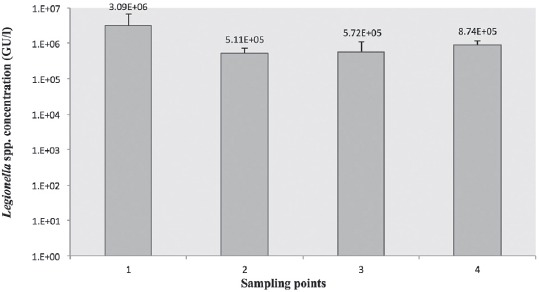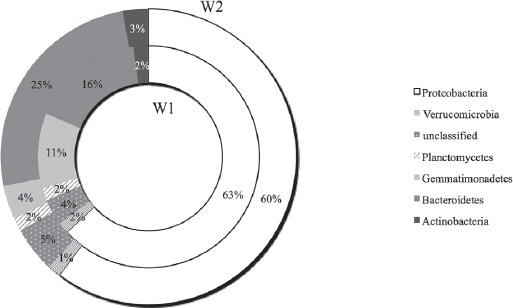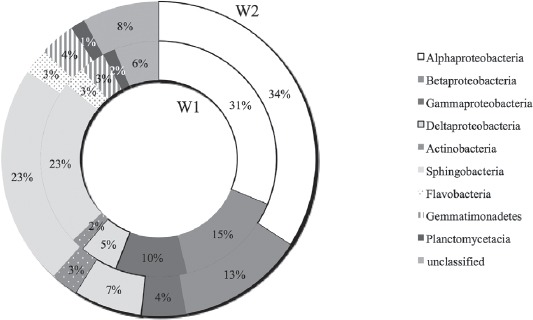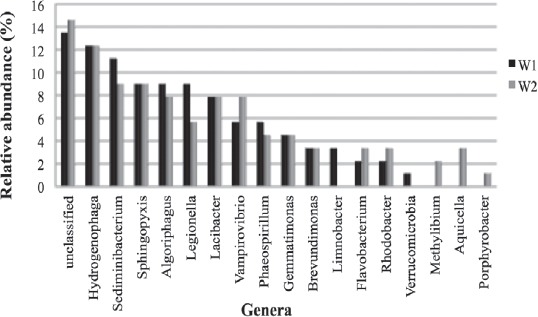Abstract
Objectives:
To investigate the presence of Legionella spp in cooling tower water. Legionella proliferation in cooling tower water has serious public health implications as it can be transmitted to humans via aerosols and cause Legionnaires’ disease.
Methods:
Samples of cooling tower water were collected from King Fahd Hospital of the University (KFHU) (Imam Abdulrahman Bin Faisal University, 2015/2016). The water samples were analyzed by a standard Legionella culture method, real-time polymerase chain reaction (RT-PCR), and 16S rRNA next-generation sequencing. In addition, the bacterial community composition was evaluated.
Results:
All samples were negative by conventional Legionella culture. In contrast, all water samples yielded positive results by real-time PCR (105 to 106 GU/L). The results of 16S rRNA next generation sequencing showed high similarity and reproducibility among the water samples. The majority of sequences were Alpha-, Beta-, and Gamma-proteobacteria, and Legionella was the predominant genus. The hydrogen-oxidizing gram-negative bacterium Hydrogenophaga was present at high abundance, indicating high metabolic activity. Sphingopyxis, which is known for its resistance to antimicrobials and as a pioneer in biofilm formation, was also detected.
Conclusion:
Our findings indicate that monitoring of Legionella in cooling tower water would be enhanced by use of both conventional culturing and molecular methods.
Legionella is a waterborne bacterium that causes Community-Acquired Pneumonia (CAP) and hospital-acquired pneumonia (HAP).1 After water distribution systems, cooling towers are the leading sources of Legionnaires’ disease outbreaks.2 These structures, which are used to cool warm water by heat transfer, have a temperature range (20 to 50°C) ideal for growth of Legionella. The water vapor released by cooling towers may contain Legionella, which can cause human infections. The Centers for Disease Control and Prevention (CDC) recommend periodic routine culturing of cooling tower water. The Occupational Safety and Health Administration (OSHA) recommends immediate action (namely, disinfection or pH adjustment) if Legionella concentrations exceed 10 Colony Forming Units (CFU)/mL. Despite the various disinfectants used, cooling tower water contamination issues persist worldwide due to inadequate maintenance and monitoring protocols.3 Multiple countries mandate Legionella reporting to prevent the spread of Legionellosis. The regulations and surveillance systems implemented include the International Health Regulations (IHR) (WHO 2007), European Working Group for Legionella Infections (EWGLI, http://www.ewgli.org), and European Legionnaires’ Disease Surveillance Network (ELDSNet) (http://ecdc.europa.eu).4 In developing countries, the incidence of healthcare-associated infections (HAI) is 2- to 20-fold higher than that in developed countries due to the lack of surveillance systems.5 Determining the optimal Legionella monitoring protocol and methods is required to improve our understanding of the behavior and responses to external factors, such as disinfectants, of Legionella and its relationship with other microorganisms.3,6 Legionella spp. surveillance is conducted primarily by conventional culturing methods. However, these have limited sensitivity, a long incubation period, and the possibility of false negative results due to bacteria’s being in a viable but not cultivable (VBNC) state.7 In contrast, nucleic acid-based methods and metagenomics have had a major impact on environmental and clinical microbiology and have in many cases replaced traditional culture dependent methods.8 Comparison of conventional culture and molecular methods would enhance our ability to rapidly detect Legionella. We thus compared standard conventional culture, real-time polymerase chain reaction (RT-PCR), and 16S rRNA next generation sequencing for Legionella surveillance and detection. Moreover, the bacterial community composition of cooling tower water was evaluated.
Methods
Water sampling
This is an environmental research study where a total of 12 water samples were collected at 4 time points from December 2015 to May 2016, from a cooling tower at King Fahd Hospital of the University (KFHU) (Imam Abdulrahman Bin Faisal University). At each time point, three water samples were taken using sterile 1-L glass bottles containing sodium thiosulfate, and transferred directly to the microbiology laboratory of the Institute for Research and Medical Consultations (IRMC) for microbiological testing and molecular analyses.
Cultivation of Legionella
Cooling tower water samples were subject to Legionella isolation and enumeration on glycine vancomycin pyrophosphate cycloheximide (GVPC) medium according to International Standard protocol ISO 11731 (ISO, 1998).9 Initially, neat and 1:10 diluted (1/10) samples were spread onto agar plates. Next, the water samples were concentrated by filtering 500-mL samples through 0.22-µm polycarbonate filters (Millipore). The bacteria were resuspended in 5 mL of sterile water by sonicating for 4 min (Grant, Cambridge, UK), and 0.2 mL of the neat and 1:10-diluted concentrates were spread on GVPC agar. Next, the concentrates were subjected to heat (50°C for 30 min) and acid (0.2 M HCl–KCl for 5 min) treatments and then spread on GPVC agar.
For each water sample, 6 GVPC plates were streaked and incubated at 37°C for 7 days. Colonies were counted after 3 and 7 days. Colonies suspected to be Legionella were incubated on BCYE agar with and without L-cysteine at 37°C for 3 days. Isolates that grew only on BCYE with L-cysteine were confirmed as Legionella. Results are expressed in CFU/L.
DNA extraction
To extract DNA, 500 mL of each water sample were filtered through 0.22-µm polyvinylidene difluoride (PVDF) filters (Millipore), and the filters were crushed using sterile pestles on dry ice. The debris was immersed in tissue lysis buffer and subjected to DNA extraction following the instructions included in the High Purity PCR Template Preparation Kit (Roche).
Legionella quantification by real-time PCR
Legionella was quantified by real-time PCR amplification of the 16S rRNA gene (386 bp) using a Rotor-Gene RG3000 thermocycler (Corbett) and Legionella mericon kit (Qiagen). The PCR reaction mixtures (20 µL) were prepared according to the manufacturer’s protocol under the following amplification conditions: 95°C for 5 min, then 40 cycles of 95°C for 15 seconds, 60°C for 15 seconds and 72°C for 10 seconds. Four standards, together with triplicate positive (included in the kit) and negative (DNA replaced with PCR-grade water) controls, were included in each PCR reaction. Rotor-Gene software (version 6) was used to analyze the data. Results were expressed as the mean genome units (GU)/L of the 3 samples obtained per time point.
Sequencing of the 16S rRNA gene
Two cooling tower water samples were analyzed by 16S rRNA next-generation sequencing. Two libraries were prepared according to the 16S metagenomic sequencing library preparation guide. A 450-bp fragment of the V3–V4 region of the 16S rRNA was amplified using Illumina barcoded primers (F515/R806; 5’-GTGCCAGCMGCCGCGGTAA-3’ /5’-GGACTACHVGGGTWTCTAAT-3’) on the Illumina Miseq platform. Indices adapted to the barcodes were added using the Nextera XT DNA Sample Preparation Index Kit (Illumina). Following amplification, the samples were purified using the AMPure XP Beads Kit (Beckman Coulter). After quantification by real-time PCR using the KAPA Library Quantification Kit (Applied Biosystems), the libraries were subjected to cluster generation and 250-bp paired-end sequencing on Miseq using the Miseq Reagent Nano Kit, version 2 (Illumina).
Sequence analyses
The fastq files generated were combined and their quality checked using FastQC software (>20). The sequences were next denoised using MOTHUR v. 1.36.0 software.10 Low-quality reads (<150 bp) and chimeras were discarded. A distance matrix was created using a cutoff of 0.2, and sequences were classified into operational taxonomic units (OTU) at a 97% similarity level. All sequences representing less than 0.005% of the total sequence reads were discarded to minimize the sequencing error rate. Each representative sequence was aligned to the SILVA bacteria database using BLASTn. Sequences identities of ≥95% and ≥97% were used as criteria for genus and species, respectively.
Accession numbers
The sequences were deposited in GenBank under the accession numbers KY077116–KY077141 for W1 and KY348802–KY348828 for W2.
Results
Legionella enumeration
Culturing on GVPC medium resulted in non-detection of Legionella spp. in all of the water samples. In contrast, Legionella concentrations in the water samples determined by real-time PCR ranged from 5.11 × 105 to 3.09 × 106 GU/L (Figure 1). Three water samples showed very close results (5.11x105 GU/l, 5.72x105 GU/l and 8.74x105 GU/l). These concentrations were slightly different from the forth sample (3.09x106 GU/l).
Figure 1.

Legionella concentrations (mean ± 2SD) in cooling tower water by real-time PCR.
Bacterial community composition
The bacterial community composition of 2 water samples from cooling tower drift was determined. Total of 10,238 high-quality sequence was obtained from the W1 library and 11,164 high-quality sequence was obtained from the W2 library. The majority of these sequences were assigned to Proteobacteria (W1, 63%; W2, 60%), Bacteroidetes (W1, 16%; W2, 25%), and Gemmatimonadetes (W1, 11%; W2, 4%) (Figure 2).
Figure 2.

Bacterial community composition of water libraries W1 and W2.
The following Proteobacteria subclasses were detected in the W1 and W2 libraries: Alphaproteobacteria (W1, 31%; W2, 34%), Betaproteobacteria (W1, 15%; W2, 13%), Gammaproteobacteria (W1, 10%; W2, 4%), and Deltaproteobacteria (W1, 5%; W2, 7%). Bacteriodetes included in majority Sphingobacteria (W1, 23%; W2, 23%) (Figure 3).
Figure 3.

Bacterial phyla detected in water libraries W1 and W2.
The sequences in library W1 was assigned to 14 genera and the sequences in library W2 was assigned to 15 genera (Figure 4). Unclassified bacteria comprised 13.5% of library W1 and 14.6% of library W2. Hydrogenophaga predominated in both libraries (relative abundance, 12%). The rest of the genera (12) were shared in majority between the 2 water samples where Sediminibacterium, sphingopyxis, Algoriphagus, Legionella, Lacibacter and Vampirovibrio exceeded 6% of relative abundance.
Figure 4.

Bacterial genera detected in water libraries W1 and W2.
Discussion
Cultivable Legionella spp
No Legionella spp. were detected by culturing. This may be due to: (1) sample preparation (concentration, sonication, and acid/heat treatment, (2) the VBNC state, or (3) the presence of bacteria that inhibit growth of Legionella on GVPC medium.7,11 According to the OSHA guidelines, a negative culture result is justification for not taking any action. In contrast, detection of 1,000–10,000 CFU/L requires immediate disinfection and review of control measures according to the EWGLI (2011).12
Total Legionella spp
Real-time PCR indicated the presence of 105 to 106 GU/L Legionella spp. in all water samples. These concentrations include both viable and non-viable Legionella, which hampers assessment of the impact on health (Figure 1). These results are in agreement with previous reports of high Legionella concentrations in natural water storage and rivers, as well as in constructed hot water systems and cooling towers.13 Moreover, the results of culture and quantitative PCR tend to show discrepancies, possibly due to protection of Legionella spp. within protozoa-like amoebae (detected by PCR) and their inability to grow on culture media.14,15 These bacteria use protozoa as a shield against disinfectants and environmental stresses such as low nutrient levels; such organisms are termed amoebae-resisting bacteria (ARB).3 Few studies of Legionella monitoring in water systems have considered amoebae.14,16 Future work should assess the involvement of free-living amoebae (FLA) with Legionella spp. in cooling tower water.
Bacterial community composition
The bacterial community composition of 2 water samples from the cooling tower drift was evaluated. Total of 10,238 high-quality sequence was obtained from library W1 and 11,164 high-quality sequence was obtained from library W2; Proteobacteria predominated in both. This phylum typically constitutes the major portion of the bacterial flora of cooling towers.17
Of the detected genera, 78% (13.5 ≤ relative abundance ≥ 3.4%) were common to both libraries. The predominant bacterium was the autotrophic hydrogen-oxidizing Hydrogenophaga.18 This bacterium is naturally present in soil and water and frequently detected in cooling towers, indicating high metabolic activity in cooling tower water.17 Sphingopyxis was also detected at high abundance (W1, 9%; W2, 9%). Sphingopyxis is a gram-negative bacterium frequently detected in water systems; it belongs to the family Sphingomonadaceae, which exhibits high level antimicrobial resistance and is a pioneer in biofilm formation.19,20 Sphingopyxis is also a possible pathogen in drinking-water distribution systems.21
Soil bacteria including Sediminibacterium (W1, 11.2%; W2, 9%), Algoriphagus (W1, 9%; W2, 7.9%), and Lacibacter (W1, 7.9%; W2, 7.9%) were also detected.22 The predominant genera were similar among the water samples, indicating high reproducibility, despite detection of unique bacteria in each water sample (relative abundance ≤3.4%) (W1, Limnobacter (3.4%) and Verrucomicrobia (1.1%); W2, Methylibium (2.2%), Aquicella (3.4%), and Porphyrobacter (1.1%)).
Limitation of the study
Legionella spp. were detected in both of the water libraries (W1, 9%; W2, 5.6%). The 450-bp 16S rRNA technique used in this study was not capable of identifying Legionella to the species level. The genus Legionella includes pathogenic species such as L. pneumophila, the causative agent of Legionnaires’ disease, which can be spread via aerosols through cooling tower drift.23 Therefore, to identify bacteria to the species level, it is necessary to sequence the full length of the 16S rRNA gene.
In conclusion, in this study, 2 molecular methods, but not a conventional culture method, successfully detected Legionella in cooling tower water. Until scientifically validated as primary methods of detection, nucleic acid-based techniques should be applied in conjunction with culturing for prescreening and monitoring of Legionella in water samples. Future work should also involve monitoring of free-living amoebae in cooling tower water.
Acknowledgment
The authors would like to thank the technical staff at the Institute for Research and Medical Consultations (Mrs. Charmeen Vilanueva Helaga) for technical support.
Footnotes
References
- 1.Phin N, Parry-Ford T, Harrison T, Stagg HR, Zhang N, Kumar K, et al. Epidemiology and clinical management of Legionnaires'disease. Lancet Infect Dis. 2014;14:1011–1021. doi: 10.1016/S1473-3099(14)70713-3. [DOI] [PubMed] [Google Scholar]
- 2.Ulleryd P, Hugosson A, Allestam G, Bernander S, Claesson BEB, Eliertz I, et al. Legionnaires'disease from a cooling tower in a community outbreak in Lidköping, Sweden-epidemological, environmental and microbiological investigation supported by meteorological modeling. BMC Infect Dis. 2012;12:313. doi: 10.1186/1471-2334-12-313. [DOI] [PMC free article] [PubMed] [Google Scholar]
- 3.Farhat M, Moletta-Denat M, Frère J, Onillon S, Trouilhé M-C, Robine E. Effects of disinfection on Legionella spp., Eukarya, and biofilms in a hot water system. Appl Environ Microbiol. 2012;78:6850–6858. doi: 10.1128/AEM.00831-12. [DOI] [PMC free article] [PubMed] [Google Scholar]
- 4.World Health organization (WHO) Legionella and prevention of Legionellosis. Geneva (CH): World Health organization; 2007. [Google Scholar]
- 5.Allegranzi B, Nejad SB, Combescure C, Graafmans W, Attar H, Donaldson L, et al. Burden of endemic health-care-associated infection in developing countries: systematic review and meta-analysis. Lancet. 2011;377:228–241. doi: 10.1016/S0140-6736(10)61458-4. [DOI] [PubMed] [Google Scholar]
- 6.Farhat M, Trouilhé M-C, Forêt C, Hater W, Moletta-Denat M, Robine E, et al. Chemical disinfection of Legionella in hot water systems biofilm: a pilot-scale 1 study. Water Sci Technol. 2011;64:708–714. doi: 10.2166/wst.2011.696. [DOI] [PubMed] [Google Scholar]
- 7.Buse HY, Schoen ME, Ashbolt NJ. Legionellae in engineered systems and use of quantitative microbial risk assessment to predict exposure. Water Res. 2012;46:921–933. doi: 10.1016/j.watres.2011.12.022. [DOI] [PubMed] [Google Scholar]
- 8.Waldor MK, Tyson G, Borenstein E, Ochman H, Moeller A, Finlay BB, et al. Where next for microbiome research? PLoS Biol. 2015;13:e1002050. doi: 10.1371/journal.pbio.1002050. [DOI] [PMC free article] [PubMed] [Google Scholar]
- 9.International Standard Organization (ISO) Geneva (CH): ISO 11731; 1998. Water quality: detection and enumeration of Legionella. From: https://www.iso.org/standard/19653.html . [Google Scholar]
- 10.Schloss PD, Westcott SL, Ryabin T, Hall JR, Hartmann M, Hollister EB, et al. Introducing mothur: open-source, platform-independent, community-supported software for describing and comparing microbial communities. Appl Environ Microbiol. 2009;75:7537–7541. doi: 10.1128/AEM.01541-09. [DOI] [PMC free article] [PubMed] [Google Scholar]
- 11.Kirschner AKT. Determination of viable Legionella in engineered water systems: do we find what we are looking for? Water Res. 2016;93:276–288. doi: 10.1016/j.watres.2016.02.016. [DOI] [PMC free article] [PubMed] [Google Scholar]
- 12.European Working Group for Legionella Infections (EWGLI) EWGLI Technical guidelines for the investigation control and prevention of travel associated Legionnaires' disease. 2011 [Google Scholar]
- 13.Whiley H, Taylor M. Legionella detection by culture and qPCR: comparing apples and oranges. Crit Rev Microbiol. 2016;42:65–74. doi: 10.3109/1040841X.2014.885930. [DOI] [PubMed] [Google Scholar]
- 14.Richards AM, Von Dwingelo JE, Price CT, Abu Kwaik Y. Cellular microbiology and molecular ecology of Legionella -amoeba interaction. Virulence. 2013;4:307–314. doi: 10.4161/viru.24290. [DOI] [PMC free article] [PubMed] [Google Scholar]
- 15.Edawaga A, Kimura A, Kawabuchi-Kurata T, Adachi S, Furuhata K, Miyamoto H. Investigation of Legionella contamination in bath water samples by culture, amoebic co-culture, and real-time quantitative PCR methods. Int J Environ Res Public Health. 2015;12:13118–13130. doi: 10.3390/ijerph121013118. [DOI] [PMC free article] [PubMed] [Google Scholar]
- 16.Springston JP, Yocavitch L. Existence and control of Legionella bacteria in building water systems: a review. J Occup Environ Hyg. 2017;14:124–134. doi: 10.1080/15459624.2016.1229481. [DOI] [PubMed] [Google Scholar]
- 17.Wang J, Liu M, Xiao H, Wu W, Xie M, Sun M, et al. Bacterial community structure in cooling water and biofilm in an industrial recirculating cooling water system. Water Sci Technol. 2013;68:940–947. doi: 10.2166/wst.2013.334. [DOI] [PubMed] [Google Scholar]
- 18.Zaitseva SV, Abidueva EYu, Namsaraev BB, Wang L, Wu L. [Microbial community of the bottom sediments of the brackish Lake Beloe (Transbaikal region)] Mikrobiologiia. 2014;83:722–729. Russian. [PubMed] [Google Scholar]
- 19.Li D, Li Z, Yu J, Cao N, Liu R, Yang M. Characterization of bacterial community structure in a drinking water distribution system during an occurrence of red water. Appl Environ Microbiol. 2010;76:7171–7180. doi: 10.1128/AEM.00832-10. [DOI] [PMC free article] [PubMed] [Google Scholar]
- 20.Vaz-Moreira I, Nunes OC, Manaia CM. Diversity and antibiotic resistance patterns of Sphingomonadaceae isolates from drinking water. Appl Environ Microbiol. 2011;77:5697–5706. doi: 10.1128/AEM.00579-11. [DOI] [PMC free article] [PubMed] [Google Scholar]
- 21.Zhang M, Liu W, Nie X, Li C, Gu J, Zhang C. Molecular analysis of bacterial communities in biofilms of a drinking water clear well. Microbes Environ. 2012;27:443–448. doi: 10.1264/jsme2.ME12035. [DOI] [PMC free article] [PubMed] [Google Scholar]
- 22.Bailey VL, Fansler SJ, Stegen JC, McGue LA. Linking microbial community structure to ß-glucosidic function in soil aggregates. ISME J. 2013;7:2044–2053. doi: 10.1038/ismej.2013.87. [DOI] [PMC free article] [PubMed] [Google Scholar]
- 23.Cohn PD, Gleason JA, Rudowski E, Tsai SM, Genese CA, Fagliano JA. Community outbreak of legionellosis and an environmental investigation into a community water system. Epidemiol Infect. 2015;143:1322–1331. doi: 10.1017/S0950268814001964. [DOI] [PMC free article] [PubMed] [Google Scholar]


